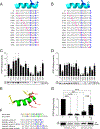Dissecting the neuroprotective interaction between the BH4 domain of BCL-w and the IP3 receptor
- PMID: 39067448
- PMCID: PMC11490406
- DOI: 10.1016/j.chembiol.2024.06.016
Dissecting the neuroprotective interaction between the BH4 domain of BCL-w and the IP3 receptor
Abstract
BCL-w is a BCL-2 family protein that promotes cell survival in tissue- and disease-specific contexts. The canonical anti-apoptotic functionality of BCL-w is mediated by a surface groove that traps the BCL-2 homology 3 (BH3) α-helices of pro-apoptotic members, blocking cell death. A distinct N-terminal portion of BCL-w, termed the BCL-2 homology 4 (BH4) domain, selectively protects axons from paclitaxel-induced degeneration by modulating IP3 receptors, a noncanonical BCL-2 family target. Given the potential of BCL-w BH4 mimetics to prevent or mitigate chemotherapy-induced peripheral neuropathy, we sought to characterize the interaction between BCL-w BH4 and the IP3 receptor, combining "staple" and alanine scanning approaches with molecular dynamics simulations. We generated and identified stapled BCL-w BH4 peptides with optimized IP3 receptor binding and neuroprotective activities. Point mutagenesis further revealed the sequence determinants for BCL-w BH4 specificity, providing a blueprint for therapeutic targeting of IP3 receptors to achieve neuroprotection.
Keywords: BCL-2 family; BCL-w; BH4 domain; IP3 receptor; axon degeneration; chemotherapy induced peripheral neuropathy; neuroprotection; paclitaxel; stapled peptide.
Copyright © 2024 Elsevier Ltd. All rights reserved.
Conflict of interest statement
Declaration of interests M.F.P.-M., G.H.B., R.A.S., and L.D.W. are named co-inventors on international patent application WO 2018/039545 (and associated patent applications and granted national patents) related to this work.
Figures




References
MeSH terms
Substances
Grants and funding
LinkOut - more resources
Full Text Sources
Other Literature Sources
Molecular Biology Databases
Research Materials

